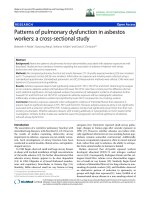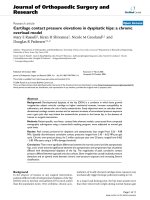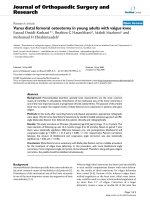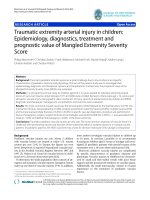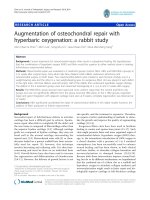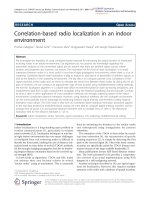Báo cáo hóa học: " Traumatic atlantoaxial rotatory subluxation in an adolescent: a case report" pot
Bạn đang xem bản rút gọn của tài liệu. Xem và tải ngay bản đầy đủ của tài liệu tại đây (1.07 MB, 5 trang )
CAS E REP O R T Open Access
Traumatic atlantoaxial rotatory subluxation in an
adolescent: a case report
Luis Enrique Meza Escobar, Georg Osterhoff
*
, Christian Ossendorf, Guido A Wanner, Hans-Peter Simmen and
Clément ML Werner
*
Abstract
Introduction: Atlantoaxial rotatory subluxation is rarely caused by trauma in adults. Usually, the treatment of
choice is traction using Halo/Gardner-Wells fixation devices for up to six weeks.
Case presentation: We present the case of a 19-year-old Caucasian woman with traumatic atlantoaxial
subluxation. Early reduction three hours after trauma and immobilization using only a soft collar were performed
and yielded very good clinical results.
Conclusion: In the adult population, atlantoaxial subluxation is a rare condition but is severe if untreated. Early
treatment implies a non-surgical approach and a good outcome. Conservative treatment is the recommended first
step for this condition.
Introduction
Atlantoaxia l rotatory subluxation is frequently observed
in children and i n patients with rheumatic arthritis, but
rarely occurs traumatically in adults [1]. A typical clini-
cal sign is torticollis [2] with lateral flexion of the neck
and contralateral rotation, known as the Cock-Robin
position [3]. Usually, the treatment of choice is traction
using Halo/Gardner-Wells fixation devices for up to six
weeks [4]. The importance of recognizing this condition
stems from the fact that it has the potential to cause
severe neural damage or even death if it is not treated
promptly [5].
We present the case of a patient with traumatic atlan-
toaxial subluxation in which early reduction, three hours
after trauma and immobilization using only a soft collar
were performed and yielded very good clinical results.
Case Presentation
While driving a van and wearing a seatbelt, a 19-year-
old Caucasian woman, was involved in a head-on vehicle
collision (speed about 40 km/hour), followed by a rear-
end hit from another vehicle. When rescue services
arrived at the scene, the patient was found sitting in her
car with her head immobilized in a left rotation. She
was transferred onto a spinal board. The application of
a stiff neck collar was not possible as her head was fixed
in the rotated position. After admittance to a regional
hospital, the physician in charge tried to reposition her
head but she reported painful paresthesia in the left
arm. She was transferred to our spine and trauma cen-
ter. Upon admittance, the woman complained about
strong, immobilizing pain in the upper cervical spine
with torticollis to the left side. A comput ed tomography
(CT) scan revealed an atlantoaxi al rotation of 46° to the
left without any signs of osseous lesions (Figure 1). The
neck was then reduce d by cautious rotation under trac-
tion with the cervical spine in flexion thus avoiding
harm by potential posttraumatic disc lesions. During
this process, the patient was awake and did not report
any new paresthetic sensations during the procedure.
There were no clinical signs of neurological sequelae
before or after reduction. However, a fluoroscopic con-
trol still showed signs of atlantoaxial pathology (Figure
2) and magnetic resonance imaging (MRI) of the cervi-
cal spine was done (Figure 3). It showed the integrity of
thetransverseandthealarligaments and a traumatic
discus protrusion on level C5/6 (Figure 4). After three
days of immobilization and analgesic therapy, a CT
(with maximum bilateral head rotation) showed no per-
sisting atlantoaxial fixation (Figure 5). Subsequently, she
was discharged three days after admittance and
* Correspondence: ;
Department of Surgery, Division of Trauma Surgery, University Hospital
Zurich, Raemistrasse 100, 8091 Zurich, Switzerland
Meza Escobar et al. Journal of Medical Case Reports 2012, 6:27
/>JOURNAL OF MEDICAL
CASE REPORTS
© 2012 Meza Escobar et al; licensee BioMed Central Ltd. T his is an Open Access article distributed under the te rms of the Creative
Commons Attribution License ( which permits unrestrict ed use, distribution, and
reprodu ction in any medium, provided th e original work is properly c ited.
immobilized in a soft collar for six weeks. At a follow-
up examination six weeks after the trauma, the pain and
paresthesia in t he left arm had rece ded completely and
the patient had a full range of motion. A follow-up MRI
of the cer vical spine showed only slight pe rsistent atlan-
toaxial rotational displacement of C1/2.
Discussion
The atlantoaxial joint is stabilized in the ante roposterior
plane by tran sverse ligaments and the joint capsule. The
alar ligaments pass from the lateral occipital processes
to the posterolateral margins of the odontoid apex and
their main function is to prevent excessive rotation of
this joint. The normal range of rotation is 40 degrees to
each side [5]. These rotational movements imply a dis-
placement of C1 over C2, leading to a loss of contact
surface between the corresponding facets on each side.
In the case of alar ligament disruption, the rotational
angle is less than 36 de grees and the contact surface
between the facets is less than 60% [6,7]. These are the
features that comprise the diagnosis of atlantoax ial sub-
luxation. Therefore, the rotational mismatch between
atlas and axis alone is not a valuable parameter to assess
the presence of atlantoaxial subluxation and an imaging
oriented classification is used.
Atlantoaxial subluxation occurs rarely in the adult
population and it is only responsible for 2.5% of all the
spinal afflictions [4]. It is predominate in the pediatric
population due to an enhanced elasticity of ligaments,
horizontally oriented, shallower joint surfaces of the lat-
eral masses, a not fully developed neck musculature and
a bigger head-body relationship [8].
Also, conditions that enhance ligamentous laxity such
as: Down Syndrome, Morquio Syndrome and Marfan
Syndrome, correlate with a higher incidence of rotatory
subluxation [9].
The importance of reco gnizing this condition is the
fact that it has the potential to c ause severe neural
damage, long term sequelae and even death if not trea-
tedpromptly.Thetimebetweentheinjuryandthe
reduction is crucial as it directly correlates with the
Figure 1 Atlantoaxial computed tomography scan. Atlantoaxial
rotation of 46° to the left.
Figure 2 Transbuccal fluoroscop y after reduction.Arrowspoint
to the asymmetric distances between the lateral masses of the atlas
and the dens axis.
Figure 3 Atlantoaxial magne tic resonan ce imaging.Arrows
point to the intact alar ligaments.
Meza Escobar et al. Journal of Medical Case Reports 2012, 6:27
/>Page 2 of 5
prognosis. If untreated after one to three months it
becomes irreducible and requires a surgical approach
[5,10]. Due to its lower incidence rate, this condition is
frequently undiagnosed or the diagnosis is delayed and
the outcome is worse [8].
Traditionally, cervical radiography was used to estab-
lish a diagnosis. It showed the persistent rotation of the
odontoid peg in relation to the lateral masses of the
atlas. Currently, the method for diagnosis is the dynamic
unenhanced cervical CT sca n, usually performed with
multiple 1 mm or 3 mm collimation, and post-imaging
three-dimensional reconstruction [11]. It allows a n
easier interpretation, follow-up and classification,
according to Fielding and Hawkins [12]:
• Type 1: rotatory s ubluxation without ante rior dis-
placement of the atlas (atlanto-odontal interval ≤3
mm)
• Type 2: rotatory subluxation wit h anterior displa-
cement of the atlas of 3 mm to 5 mm
• Type 3: rotatory subluxation wit h anterior displa-
cement of the atlas of > 5 mm
• Type 4: rotatory subluxation with posteri or displa-
cement of the atlas.
As mentioned above, the delay between injury and
reduction predisposes to the recurrence of this condi-
tion and the failure to heal after non-surgical
management with the consequent loss of mobility of the
upper cervical spine [13].
The management goals of a patient with this condi-
tion are to treat the instability of the atlantoaxial joint,
restore and prevent possible effects of neurological com-
promise and to achieve the normal pain-free motion of
this joint. Conservative treatment using analgesics, with
halter traction or closed reduction maneuvers, is the
first step in the treatment of this condition [6,8,13,14].
The decision to take a surgical approach is based on
the stability of the joint, its re-dislocation and on the
compromise of the transverse alar ligaments. Compared
to conservative management, the arthrodesis of the
atlantoaxial joint results in a loss of rotation to each
side and therefore it is not recommended as the initial
treatment [15].
In patients with diagnosed lesions of the cervical
spine, concomitant injuries have to be considered. In
our case, the patient had an additional epidural hema-
toma or disc protrusion on level C5/6. This injury
might pose a danger to the patient during a closed
reduction maneuver if the patient’sawarenessis
impaired. Therefore, it is neces sary to perform both CT
and MRI before reduction on these patients. In our
case, however, the patient was awake and would have
been able to report any new paresthetic sensations.
There was neither fracture nor instab ility nor rupture of
alar ligaments. This qualified her for conservative
Figure 4 Sagittal magnetic resonance imaging (T2). The magnetic resonance imaging scan of the cervical spine on the day of trauma (A)
shows an epidural mass (arrows) dorsally to C5/C6 - probably a hematoma or a disc protrusion, without signs of myelopathy. Six weeks later (B)
the mass has decreased in size, the remaining disc C5/C6 is intact.
Meza Escobar et al. Journal of Medical Case Reports 2012, 6:27
/>Page 3 of 5
management. Some authors suggest treatment with trac-
tion and a subsequent halo body jacket for eight to 1 2
weeks for these patients [8,16].
It has been shown that wearing soft collars produces
less motion of the cervical spine in conscious patients
[17], even though it would work more likely as a remin-
der to the patient to restrict his or her own motion [18].
This is especially important to avoid the critical end
range rotation.
It was decided that the patient, being very young, and
therefore having l igaments of higher elasticity [19], b e
immobilized in a soft collar for six weeks. To the best of
our knowledge this is the first time this treatment has
been reported for atlantoaxial s ubluxation, without the
need for halo fixation and while achieving a good clini-
cal outcome.
Conclusion
Atlantoaxial subluxation is a rare, but severe if
untreated, condition in the adult population. The best
way to ensure the diagnosis properly is by using a
dynamic unenhanced cervical CT with po sterior three-
dimensional reconstruction. The delay between injury
and management affects the prognosis. Early treatment
implies a non-surgical approach and a better outcome.
Conservative treatment is the first step with this
condition.
Consent
Written informed consent was obtained from the patient
for publication of this case report and any accompany-
ing images. A copy of the written consent is available
for review by the Editor-in-Chief of this journal.
Authors’ contributions
EME and GO participated in data research for the case report, designed the
figures and drafted the manuscript. CO participated in data research for the
case report and in drafting the manuscript. GW and HPS were involved in
the surgical decision making and revised the manuscript. CW had the idea
for this case report, performed the surgical procedures, was involved in the
analysis of the data and revised the manuscript. All authors read and
approved the final manuscript.
Competing interests
The authors declare that they have no competing interests.
Received: 22 August 2011 Accepted: 23 January 2012
Published: 23 January 2012
References
1. Crook TB, Enyon CA: Traumatic atlantoaxial rotatory subluxation. Emerg
Med J 2005, 22:671-672.
2. Singh VK, Singh PK: Traumatic bilateral atlantoaxial rotatory subluxation
mimicking as torticollis in an adult female. J Clin Neurosci 2009,
16:721-722.
3. Fielding JW, Williams RJ: Atlanto-axial rotatory fixation. J Bone Joint Surg
1977, 59:37-44.
4. Henning P, Krettek C, Mueller CW: Die traumatische atlantoaxiale
Dislokation. Manuelle Med 2010, 48:199-204.
5. Maile S, Slongo T: Atlantoaxial rotatory subluxation: realignment and
discharge within 48 h. Eur J Emerg Med 2007, 14:167-169.
6. Willauschus WG, Kladny B, Beyer WF, Glückert K, Arnold H, Scheithauer R:
Lesions of the alar ligaments. In vivo and in vitro studies with magnetic
resonance imaging. Spine 1995, 20:2493-2498.
7. Moenckeberg JE, Tomé CV, Matias A, Alonso A, Vásquez J, Zubieta JL: CT
Scan Study of Atlantoaxial Rotatory Mobility in asymptomatic Adult
Subjects. Spine 2009, 34:1292-1295.
8. Weisskopf M, Naeve D, Ruf M, Harms J, Jeszensky D: Therapeutic options
and results following fixed atlantoaxial rotatory dislocations. Eur Spine J
2005, 14:61-68.
9. Mathern GW, Batzdorf U: Grisel’s syndrome. Cervical spine clinical,
pathologic, and neurologic manifestations. Clin Orthop 1989, 244:131-146.
10. Coutts MB: Atlanto-epistropheal subluxations. Arch Surg 1934, 29:297-311.
11. Wang K, Loke TKL: Computed tomography of paediatric atlanto-axial
rotatory subluxation: the multiple image addition method. J HK Coll
Radiol 2001, 4:209-212.
12. Fielding JW, Hawkins RJ: Atlanto-axial rotatory fixation (fixed rotatory
subluxation of the atlanto-axial joint). J Bone Joint Surg Am 1977, 59:37-44.
13. Subach BR, McLaughlin R, Albright AL, Pollack IF: Current management of
paediatric atlantoaxial rotatory subluxation. Spine 1998, 23:2174-2179.
14. Phillips WA, Hensinger RN: The management of rotatory atlanto-axial
subluxation in children. J Bone Joint Surg Am 1989, 71:664-668.
15. Dvorak J, Penning L, Hayek J, Panjabi MM, Grob D, Zehnder R: Functional
diagnostics of the cervical spine using computer tomography.
Neuroradiology 1988, 30:132-137.
16.
Suchomel P, Choutka O: Reconstruction of upper cervical spine and
craniovertebral junction. 2011, 215-218, ISBN 9783642131578.
17. Carter VM, Fasen JA, Roman JM Jr, Hayes KW, Petersen CM: The effect of a
soft collar, used as normally recommended or reversed, on three planes
of cervical range of motion. J Orthop Sports Phys Ther 1996, 23:209-215.
18. Johnson RM, Owen JR, Hart DL, Callahan RA: Cervical orthoses: a guide to
their selection and use. Clin Orthop Relat Res 1981, 154:34-45.
19. Barros EM, Rodrigues CJ, Rodrigues NR, Oliveira RP, Barros TE, Rodrigues AJ
Jr: Aging of the elastic and collagen fibers in the human cervical
interspinous ligaments. Spine J 2002, 2(1):57-62.
Figure 5 Rotatory computed tomography scan.Atlas(A+B)
and axis (C+D) with the head rotated to the left (A + C) and to
the right (B+D).
Meza Escobar et al. Journal of Medical Case Reports 2012, 6:27
/>Page 4 of 5
doi:10.1186/1752-1947-6-27
Cite this article as: Meza Escobar et al.: Traumatic atlantoaxial rotatory
subluxation in an adolescent: a case report. Journal of Medical Case
Reports 2012 6:27.
Submit your next manuscript to BioMed Central
and take full advantage of:
• Convenient online submission
• Thorough peer review
• No space constraints or color figure charges
• Immediate publication on acceptance
• Inclusion in PubMed, CAS, Scopus and Google Scholar
• Research which is freely available for redistribution
Submit your manuscript at
www.biomedcentral.com/submit
Meza Escobar et al. Journal of Medical Case Reports 2012, 6:27
/>Page 5 of 5

